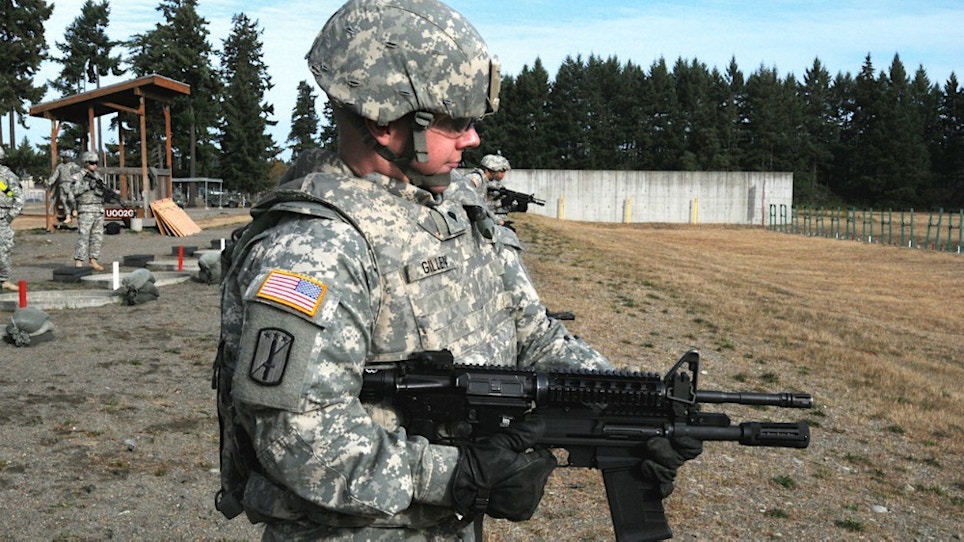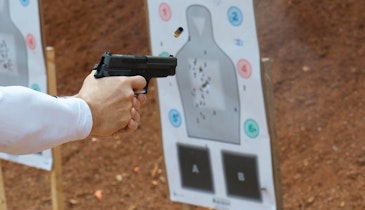
Shotguns have been in common use in their modern form by the United States military since the 19th century and even earlier if you consider that standard muskets could be fired with buckshot rather than the standard musket ball, as was the case going back to the War of 1812.
Shotguns have been in common use in their modern form by the United States military since the 19th century and even earlier if you consider that standard muskets could be fired with buckshot rather than the standard musket ball, as was the case going back to the War of 1812.
Traditionally, shotgun procurement was based on an urgent need and satisfied with commercial off-the-shelf buys. The longer a shotgun was in use, the design would be modified to accommodate military use such as the addition of heat shields for barrels.
While a multitude of shotguns have been adopted for use over the years, these are the most iconic.
Undoubtedly the most famous of U.S. military shotguns is the Winchester Model 1897, which was initially adopted in 1900 for use in the Philippines campaign of the Spanish-American War and remained in active service well until World War II. Adopted as the M1897 Trench Gun, this 12-gauge pump-action shotgun is well known for its distinctive exposed hammer.
As there is no trigger disconnector, so it could be slam fired by working the slide while holding the trigger to the rear. Some users went so far as to wire the triggers to the rear. The M1897 differed from the standard Winchester 1897 by the addition of a perforated heatshield for the barrel and a lug to accommodate the very impressive M1917 bayonet with its 17-inch blade. It could be easily wielded within the confines of a trench line due to its 20-inch barrel, and became lovingly known as the “Trench Sweeper” to the Doughboys.
Various models of the Remington 870 have been in use since the 1960s, and have often been referred to as “riot guns.” Some have been used by the Air Force to keep runways clear of birds. The most recent version is the M870 Modular Combat Shotgun, which like other, newer guns, replaces the old wood furniture for a skeltonized stock, pistol grip and polymer forend.
Although it never saw widespread issue within Special Operations, Knights Armaments Co. developed an 870 variant called the Masterkey, which is designed to be attached below the barrel of an M4 carbine in a manner similar to an M203 Grenade Launcher. It was intended to become part of the Special Operations Peculiar (SOPMOD) Kit for carbines.
The Mossberg 500 series has also been in service since the 1960s, including the 500, 590 and 590A1 models. It, too, has seen upgrades. Within the past decade, the U.S. Navy, Marine Corps and Army’s Special Operations Command have adopted a Mission Enhancement Kit for their Mossberg 500 and 590 shotguns, which includes three different stock options (M-4 carbine-style collapsible buttstock a pistol grip and fixed buttstock), a sling system, a Picatinny rail-equipped forearm, a shotgun retention system, and an 18-inch breaching barrel. Primarily a breaching tool, these are used by Army Special Operators and Marine Corps reconnaissance, security forces, military police, explosive ordnance disposal and special operations units.
Rather than buying firearms off-the-shelf, the next two shotguns were procured as dedicated combat shotguns with specific requirements.
The M1014 Joint Service Combat Shotgun is a militarized version of the Benelli M4 Super 90. It entered service in 1999 after winning a full and open solicitation against several competitors. Intended to replace most other shotguns in the inventory at the time, it is the only type-classified semiautomatic shotgun currently in the inventory. Initial deliveries were to the U.S. Marine Corps, although every service now uses them.
In addition to a collapsible stock, ghost ring sights and Picatinny rail, the weapon incorporates a self-regulating gas system that compensates for shell length and whether standard or magnum load. For instance, 2 3/4-inch and 3-inch shells can be fired in any combination semi-automatically. However, low power, less-than-lethal rounds must be hand-cycled.
The latest shotgun to enter U.S. Army service is the M26 Modular Accessory Shotgun System (MASS) that, as with the earlier KAC Masterkey 870, mounts below the barrel of an M4 carbine. There is also a stock and pistol grip for standalone use. Developed by C-More Systems as the Lightweight Shotgun System, this magazine-fed, single-shot weapon utilizes a manual side mounted bolt to chamber each round.
Shotguns will remain in the U.S. arsenal for the foreseeable future with operations in urban areas keeping demand high. In spite of programs for newer models such as the M1014 Joint Service Combat Shotgun and M26 Modular Accessory Shotgun System, older shotguns including the Remington 870 and Mossberg M590A1 remain in service, although in small numbers. However, don’t be surprised to find even more exotic examples in various arms rooms, particularly in the reserve forces.





